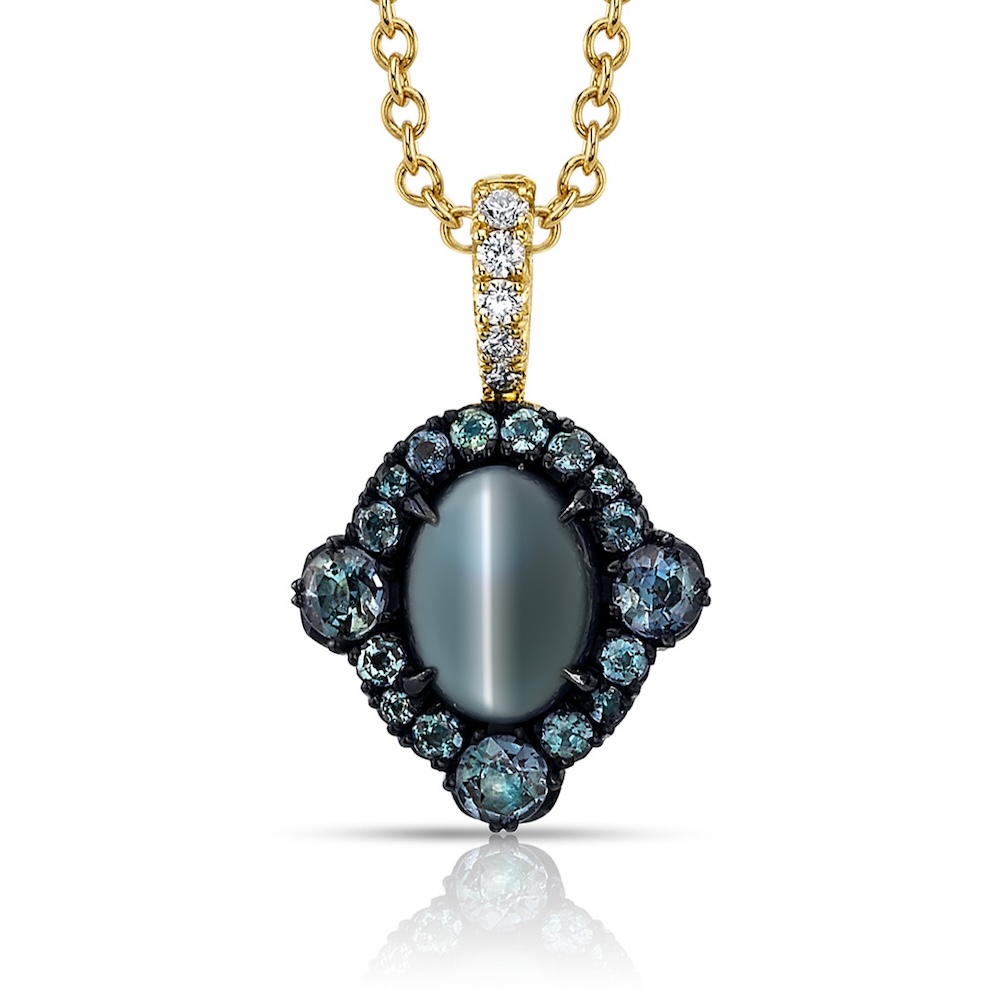Sponsored Content
Stars and Cat's Eyes- Asterism and Chayoyancy
Wade Abel, CG, Director of Gemology, American Gem Society
Gemstones, beyond their exquisite colors and dazzling sparkle, can have unique optical phenomena that add an extra layer of allure. Understanding these phenomena is crucial when describing them to a customer, emphasizing the gem’s unique attributes. These features not only elevate jewelry design but also enhance aesthetic appeal, rarity, and overall value.
STARS AND CAT’S EYES
Asterism and chatoyancy are two enchanting optical phenomena displaying their celestial and feline-inspired effects. The occurrence of these effects is the result of similar structures within the gemstone. Let’s look at each, what makes them unique, the gemstones in which they are commonly found, how they are fashioned for jewelry, and their synthetic and imitation counterparts.
ASTERISM
Asterism is an optical phenomenon defined by a star- like pattern illuminated by a single light source. The name comes from “aster,” the Latin word for star.
The most common gemstones that can display this star-like pattern include corundum (including ruby and sapphire), diopside, quartz, and almandine garnet. The ethereal appearance of this phenomenon is caused by the presence of needle-like inclusions within the gemstone, commonly rutile in corundum or magnetite in diopside. These thin inclusions must be arranged in specific crystallographic directions to produce the star pattern. The number of rays of the star is directly related to the crystal structure of the gem material, either four or six rays.
Corundum, for example, has a trigonal crystal structure. The repeated pattern of crystal growth allows for these fine needles to be oriented in three directions. As the light reflects off the abundance of perfectly positioned intersecting inclusions, the star is born. For diopside, a gemstone in the monoclinic crystal system, the needles follow two intersecting directions of crystal growth creating a four-rayed star.
CHATOYANCY
The term “chatoyancy” originates from the French words meaning “cat” and “eye” making this is a very descriptive term for this optical effect that looks like the thin slit of a cat’s pupil!
Similar to asterism, chatoyancy results from light reflecting off fibrous inclusions—either needles or minuscule tubes arranged parallel to each other and orientated in only one direction. Stacked close together, these inclusions create a concentrated band of reflected light.
Chatoyancy is commonly found in chrysoberyl, tourmaline, the aptly named, tiger’s eye, and alexandrite.
FASHIONING GEMS WITH ASTERISM AND CHATOYANCY
When a gem crystal has the correct inclusions to produce asterism or chatoyancy, it is up to the lapidary to bring out the celestial star, or perfect cat’s eye. The goal is to achieve well-centered bands of concentrated light, optimizing visual impact. For this, the gem must be cut with the orientation of the inclusions parallel to the base of the gem. The gems are also cut into cabochons which provide a domed top for the optical effect to effortlessly glide across. The best way to illuminate the gem for either phenomenon is with a single focused light source, like a pen light or the sun, to concentrate the reflections radiating from the inclusions.
SYNTHETICS AND IMITATIONS
The asterism effect in synthetic sapphire and synthetic ruby can be induced in the growth process when the gems are synthesized with the Verneuil flame fusion method and annealed. Also, the cat’s eye effect can be reproduced with fiberoptic glass with many extremely thin glass rods fused in one direction as an imitation for cat’s eye gemstones.
These synthetics and imitations will often have very sharp defined star rays or cat’s eyes. This is not to say that
their natural counterparts cannot have beautiful, sharp rays; however, it is rarer. As always, full disclosure of natural or synthetic origin is needed and transparency regarding the material is extremely important.
A RARE PHENOMENON
Considering the exact conditions required for these beautiful effects to be present in natural gems, it is understandable how rare a gem is that exhibits a sharp, centered star or cat’s eye. While the value of colored gems primarily relies on hue, the combination of color and optical phenomenon can create jewelry dancing with wonder! A gem with a well-defined star or cat’s eye becomes a testament to nature’s artistry and human craftsmanship.

American Gem Society (AGS) members must adhere to a Code of Ethics that helps increase customer confidence in their shopping experience. AGS titleholders have professional credentials that prove they are up to date with industry developments and regulations because they must recertify annually with education and an exam. Overall, it comes down to understanding the guidelines that need to be followed and a knowledgeable sales team that can incorporate clear, accurate, and honest communication to help inform the customer. This promotes consumer protection and integrity in the industry and helps customers appreciate their purchase.







